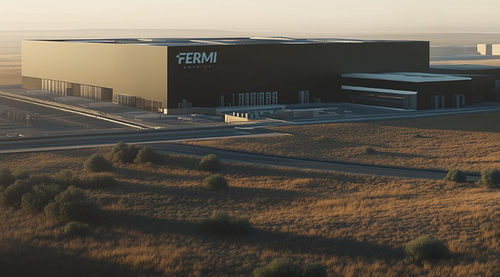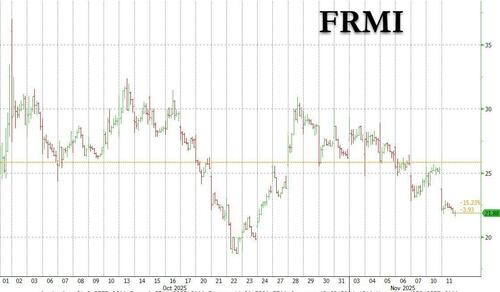Fermi’s Massive Texas Data Center Struggles To Sign Its First Major Tenant
More storms clouds are gathering over the torrid, and in some cases chaotic, rollout of US data centers.
Fermi’s massive 11 GW energy and data center project in Texas, called Project Matador, which the company has envisioned to be the world’s largest AI data center and energy campus in the Texas Panhandle, near Amarillo, is struggling to close the deal with its first major data center tenant. And since Fermi is set up as REIT that allocates income from tenants to shareholders, the delay may raise doubts about attracting other potential money-generating tenants, in a toxic feedback loop.
Fermi’s Donald J. Trump campus is an array of solar, natural gas and nuclear power generation, as well as storage and 2.6 million square feet of data-center capacity. With 11 gigawatts of power, including 6 gigawatts of nuclear power and 5 gigawatts of gas-powered generation, Project Matador ranks as the “largest advanced energy and data campus in the world” to deliver next-generation AI at scale, Fermi said.

Besides the name of the plant, the company has ties to Trump through Rick Perry, a co-founder and board member. The latest filings show that Perry owned a little more than 16.5 million Fermi shares, which represented 2.5% of the shares outstanding.
Fermi CEO Toby Neugebauer said Fermi’s goal is to catch up in November and regain the roughly 21-day delay in signing its first tenant with “intense” face-to-face meetings. It expects the lease to be signed in the current fourth quarter.
“I wouldn’t take anything as a sign of weakness with that delay,” Neugebauer told Wall Street analysts. “I would just say, you know, these are very large corporations who have multiple different stakeholders who have to sign off on everything that’s agreed to. And sometimes that takes longer than the commercial guys would prefer.”
It’s not all bad news. The company which went public on Oct 1, said it is still on track to start generating power next year; it has also already reached some major milestones with respect to regulatory progress with the NRC, as well as securing the permitting for the initial 6 GW of gas turbine power.
Progress with the NRC has included acceptance of their initial portion of a combined license application (COLA) for four Westinghouse AP1000 reactors, achieved back in early September. Fermi has since submitted additional portions of the application, and will continue to submit the remainder of the required portions over the next year. This process could be sped up considerably if required environmental pre-work is reduced due to NEPA regulation revisions. The NRC has also agreed to an 18-month review timeline after the application is fully submitted. Fermi signed a Front-End Engineering Design contract with Hyundai E&C in October, with forging of long-lead nuclear components by Doosan Enerbility now in production
Last month, Fermi also scored a major win that has stifled the development of an endless number of data centers in the US. They were able to secure over 2.5 million gallons of water per day from the city of Amarillo, and agreed to pay twice the rate typically charged. Their location near one of the largest aquifers in the world has proven to be a huge benefit.
For gas power, earlier this month, the Texas Commission on Environmental Quality granted preliminary approval for 6 GW of natural gas-based power generation, marking over half the project’s capacity and positioning it as one of the world’s largest such facilities. This approval, subject to additional discussions and close out administrative proceedings, integrates combined-cycle gas turbines with the first gigawatt targeted for coming online by late 2026.
While the regulatory rollout for the Trump-linked Fermi is going according to plan, the company’s latest headache appears to be with bringing potential tenants to the table for signing formal lease agreements.
While Fermi did not name the prospective tenant, it described it as an investment grade-rated corporation with power needs, and which has signed a letter of intent for a 20-year term, plus four additional five year blocks, in addition to advancing $150 million for the purpose of beginning some construction.
Investors are concerned with the 21-day delay in signing on the tenant, but management argues that the delay is not a sign of cold feet, and instead point to the $150 million construction advance as a sign of good faith, claiming investors should not be concerned with continued progress across multiple fronts.
It is also hard to imagine a data center would not see the benefit of signing with Project Matador due to the massive delays experienced at other locations with regards to securing permits or power, such as the recent headaches seen in California.
Project Matador is in many ways the embodiment of the Trump administration’s goals of building AI data center infrastructure in the United States as fast as possible, along with ensuring the majority of that is powered by nuclear energy. With constant reference to the AI race being the new “Manhattan Project”, it is hard to imagine the administration will not do everything within its power to ensure the success of America in the new global arms race.
That said Fermi’s stock fell Tuesday as investors brushed aside some positive developments announced in the company’s first release of quarterly results, such as beating an internal estimate for the amount of gas-fired generation it expects to bring online in 2026; following the news of the delay, FRMI is almost back to its post IPO lows.
The company reported a net loss for the first nine months of 2025 of $332 million, including $173.8 million in “charitable contributions”, $111.6 million of losses related to convertible notes and other securities. Fermi also said it expects to have about 2.2 gigawatts of gas-fired generation secured or under letter of intent in 2026, up from its initial target for 1 gigawatt from earlier this year.
Tyler Durden
Tue, 11/11/2025 – 20:30ZeroHedge NewsRead More












